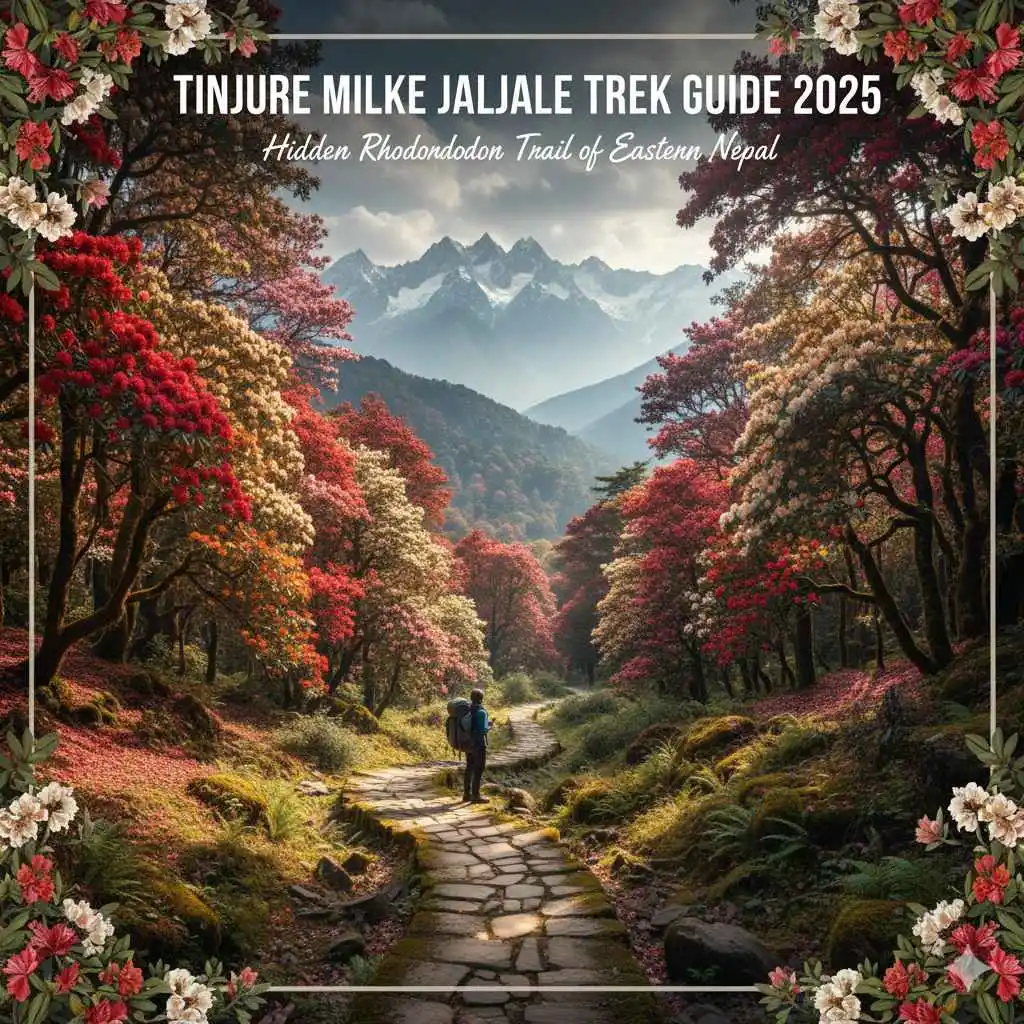
Tinjure Milke Jaljale Trek
The Tinjure Milke Jaljale Trek is one of Nepal’s best-kept secrets a mesmerizing journey through the rolling hills, lush forests, and blooming rhododendrons of Eastern Nepal. Often called the “Rhododendron Capital of Nepal”, this trail offers panoramic views of the Kanchenjunga, Makalu, and Everest ranges, making it a paradise for trekkers seeking peace, nature, and authentic local culture.
Unlike the crowded Everest or Annapurna trails, the Tinjure Milke Jaljale Trek remains relatively untouched, giving visitors a chance to experience Nepal’s pristine beauty, warm village hospitality, and unique biodiversity.
Where is Tinjure Milke Jaljale Located?
The Tinjure Milke Jaljale region lies between Tehrathum, Sankhuwasabha, and Taplejung districts in Eastern Nepal. It forms part of the Milke Danda Ridge, a high-altitude area famous for its vibrant rhododendron forests home to more than 30 species of rhododendrons!
The trek starts from Basantapur (in Tehrathum) and follows a trail through picturesque villages like Tinjure, Gupha Pokhari, and Jaljale, before returning or connecting to other routes toward Taplejung or even the Kanchenjunga region.
Why Choose the Tinjure Milke Jaljale Trek?
Here’s why this trail deserves a top spot on your travel list in 2025:
Rhododendron Wonderland: In spring (March–April), the hills explode with colors red, pink, and white blossoms fill the landscape.
Panoramic Mountain Views: On a clear day, you can see three of the world’s highest peaks Everest, Kanchenjunga, and Makalu.
Authentic Village Life: Experience the rich culture of Limbu, Rai, and Gurung communities.
Biodiversity Hotspot: The region is home to various bird species, orchids, and medicinal plants.
Peaceful and Untouched: Perfect for trekkers who love solitude and offbeat trails.
Best Time for the Tinjure Milke Jaljale Trek
The best seasons are:
Spring (March to May): The rhododendron forests are in full bloom the trail looks magical.
Autumn (September to November): Crisp weather, clear mountain views, and cultural festivals make this an ideal trekking season.
Avoid the heavy monsoon (June–August) as the trails can be slippery, and winter (December–February) can be cold in higher elevations.
Tinjure Milke Jaljale Trek Itinerary (7–9 Days)
Here’s a sample 7-day itinerary for an unforgettable experience:
| Day | Itinerary | Highlights |
|---|---|---|
| 1 | Kathmandu to Basantapur (by flight to Biratnagar & drive) | Scenic travel through Terai plains to the hills |
| 2 | Basantapur to Chauki | Trek through lush forests and small villages |
| 3 | Chauki to Gupha Pokhari (2,890m) | Visit sacred pond, panoramic mountain views |
| 4 | Gupha Pokhari to Tinjure Danda | Hike through dense rhododendron forests |
| 5 | Tinjure Danda to Jaljale (3,100m) | Breathtaking sunrise and Himalayan panorama |
| 6 | Return trek to Basantapur | Downhill walk with scenic photography |
| 7 | Drive/Fly back to Kathmandu | End of the journey |
You can extend this trek by connecting it to the Kanchenjunga or Makalu trail if you have more time.
Accommodation and Food
Unlike major trekking routes, the Tinjure Milke Jaljale Trek has limited infrastructure. You’ll mostly stay in local homestays and teahouses, enjoying authentic Eastern Nepali dishes like dhido, gundruk, and local millet beer (tongba).
Travelers often find these local stays more memorable the warm hospitality and home-cooked meals make the experience truly special.
Trekking Cost Estimate (2025 Update)
| Expense | Estimated Cost (USD) |
|---|---|
| Trekking Permits | $20–$30 |
| Accommodation (per night) | $10–$20 |
| Meals (per day) | $15–$25 |
| Local Guide (optional) | $25–$35/day |
| Transportation (Kathmandu–Basantapur) | $50–$80 (one way) |
Total Budget: Around $400–$600 per person for a week-long trek, depending on your comfort level.
Permits and Entry Requirements
The Tinjure Milke Jaljale Trek falls within the Makalu-Barun Conservation Area zone in some sections, so you may need a TIMS (Trekkers’ Information Management System) card and a local area permit.
You can easily obtain them in Kathmandu or at the Tourism Office in Basantapur.
How to Reach the Trailhead
By Air: Take a flight from Kathmandu to Biratnagar (50 minutes), then drive to Basantapur (8–9 hours).
By Road: A direct bus from Kathmandu to Basantapur takes around 14–16 hours.
Local Option: You can also start from Dhankuta or Hile, connecting via local transport to Basantapur.
Top Attractions Along the Trail
Gupha Pokhari: A serene pond sacred to both Hindus and Buddhists.
Milke Danda Ridge: Known for rhododendron forests and panoramic Himalayan views.
Tinjure Danda: Offers sunrise views of Kanchenjunga and Makalu.
Local Villages: Experience unique Limbu culture, traditional houses, and rural Nepalese life.
Responsible and Sustainable Trekking Tips
Carry a reusable water bottle and avoid plastic waste.
Support local homestays and buy local products.
Respect local customs and religious sites.
Trek with a local guide to support the community economy.
Frequently Asked Questions (FAQs)
1. How difficult is the Tinjure Milke Jaljale Trek?
It’s a moderate-level trek, suitable for beginners and experienced trekkers.
2. Do I need a guide?
A guide isn’t mandatory but highly recommended for local navigation and cultural insights.
3. What is Tinjure famous for?
The Tinjure Milke Jaljale Trek is famous for its rhododendron forests and stunning Himalayan views.
4. Is camping required?
No, most routes now have homestays and basic teahouses available.
5. Can I do this trek solo?
Yes, it’s safe to trek solo, but always inform locals about your route for safety.
The Tinjure Milke Jaljale Trek is more than just a journey it’s an experience of Nepal’s natural elegance and cultural heart. For those who love solitude, vibrant rhododendrons, and authentic local interactions, this trek is an unmissable adventure in 2025.
So, pack your bags, grab your camera, and step into Eastern Nepal’s hidden paradise where every turn of the trail paints a new story of beauty, culture, and peace.

